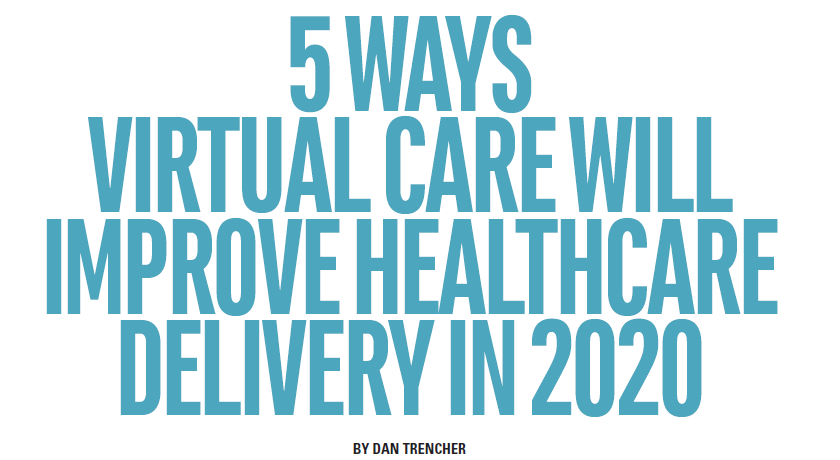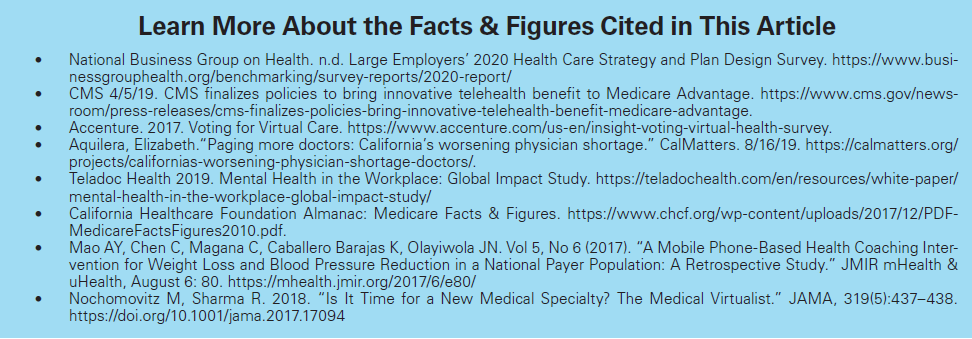
As the state legislature-mandated Council on Health Care Delivery Systems continues to explore the best way to structure, implement and pay for universal access to healthcare for all California residents, California brokers, plan sponsors and benefits administrators will no doubt see an expanding role for virtual care. It is one aspect of healthcare delivery that brokers and others will increasingly rely on and will likely be a crucial element of whatever recommendations are made.
Below are five virtual care predictions brokers will likely see play out in 2020 and beyond:
- Virtual care becomes a top priority for large employers, health systems, and public plans.
With mounting pressures to improve access while controlling costs, the importance of virtual care is increasing for nearly all U.S. health plans, and the majority are offering or considering services. Building off the virtual care programs almost all large employers currently offer, 51% of large employers say that expanding virtual care options they offer to their employees is a top priority in 2020. Sixty-four percent of U.S. hospitals and health systems now offer consumer virtual care programs, and an additional 24% plan to provide consumer telemedicine by year’s end. As for public plans, the Center for Medicare and Medicaid Services opened the door for innovative care models with a landmark regulatory shift for the more than 3.4 million California residents enrolled in Medicare Advantage Plus plans.
- Consumers will increasingly demand integrated, personalized care on their terms.
Thanks to digital and “big data” technologies, built around gaining consumer insights and uncovering trends, choice abounds in terms of where individuals turn to access products and services. Because of the depth and breadth of “big data” availability, it is now possible to customize and personalize nearly all aspects of customers’ online experiences. Consumers increasingly demand such personalization when it comes to their healthcare needs as well. Virtual care enables people to get the right treatment at the right time for resolution of their needs and, as a result, utilization and advocacy are accelerating. Already, more than 70% of American consumers express interest in virtual care as it provides a broader range of choices in providers, services offered, and when, where, and how those services are received.
A strong selling point for California brokers when speaking with clients is that customer satisfaction among users of telehealth services ranks among the highest of any consumer category studied by J.D. Power.
- Virtual care will help close the access gap for mental healthcare
As the infographic below demonstrates, a study of employees across the United States found only 20% felt mentally and emotionally healthy over a two-week period. That should be a wakeup call for all plan sponsors and benefits managers given the adverse effects of mental illnesses such as depression and anxiety have on productivity, decision-making, and interactions with other employees and customers. And stigma remains one of the most significant barriers to seeking help: 82% of employees who have had a mental health diagnosis hid their difficulties from workplace management, mainly because they feared a negative impact on their career.
For those who do seek care, access is challenging due to the limited availability of mental health professionals. Virtual care must disrupt the status quo to close the gap and create adequate access to mental healthcare.
Moreover, virtual care has proven successful in relieving symptoms and restoring mental health. Seventy-six percent of patients with depression reported improvement after the third visit with a virtual care mental health provider. With reduced stigma and fewer barriers to care, more people get the right diagnoses, action plans, and support needed to be mentally well and productive in work and life.
- Virtual care will reduce the challenges of treating people with chronic diseases.
Seventy-nine percent of California Medicare beneficiaries report having two or more chronic conditions, and 37% report four or more. Beyond the skyrocketing cost of care, managing multiple chronic conditions poses complex challenges for individuals who are juggling treatments, fighting fatigue, facing physical limitations and who are hamstrung by behavioral health issues.
Virtual care makes it easier for people to manage chronic conditions from the comfort of home and with the support of personal caregivers who can join virtual visits. And for many conditions, virtual care proves more effective than in-person visits as a result of better care coordination and fewer barriers to access such as distance, mobility, and time constraints. For example, in a recent virtual care coaching study, 49% of participants with high blood pressure improved by an entire hypertensive stage, and 40% of those who participated in a virtual diabetes prevention program lost more than 5% of their total body weight.
- Physicians will increasingly seek training/support to provide effective virtual care to better treat and diagnose patients who live in areas with few local providers.
By 2030, California could be short by as many as 10,000 primary care clinicians, including nurse practitioners and physician assistants. Some areas — the Central Valley, Central Coast, and Southern Border region — will be hit especially hard. So too will be remote rural and inner-city residents, communities of color, the elderly, those with mental illness or addiction, and those without health coverage.
Many people will be forced to wait longer for doctor visits and to travel further distances to see someone. They may become so discouraged they forego preventive care ̶ and even care for chronic, serious disease ̶ until emergency treatment is necessary.
Enter the rise of a new medical specialty: the virtualist. Specially trained to interface with patients through virtual care, virtualist physicians are supported by technology and clinical protocols that enable consistent, high-quality care, and exceptional patient experience. In addition to medical training, physicians must have multi-disciplinary education on virtual care policy, clinical quality practices, and communication skills for effective patient interactions. Medical schools and healthcare organizations must educate the leaders of tomorrow to master virtual care to provide the care that patients need, when, and how they need it.
Facing a shortage of qualified physicians and other healthcare practitioners, a large aging population suffering from chronic diseases, and government, businesses and consumers alike all clamoring for increased access, better service and lower healthcare costs, virtual care will increasingly serve as the ‘front door’ to access healthcare services in the near future.

Dan Trencher is senior vice president of product & corporate strategy for Teladoc Health, overseeing the development and execution of new business initiatives that deliver compelling user experiences and transforms how people access quality care. He ensures that Teladoc Health provides innovative commercial products, leading long-term road mapping, market analysis, product development and management, and project execution. Reach Dan at dtrencher@teladochealth.com

